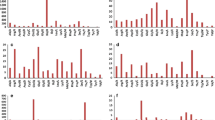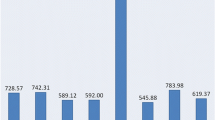Abstract:
Improving the quality of the non-climacteric fruit, pineapple, is possible with information on the expression of genes that occur during the process of fruit ripening. This can be made known though the generation of partial mRNA transcript sequences known as expressed sequence tags (ESTs). ESTs are useful not only for gene discovery but also function as a resource for the identification of molecular markers, such as simple sequence repeats (SSRs). This paper reports on firstly, the construction of a normalized library of the mature green pineapple fruit and secondly, the mining of EST-SSRs markers using the newly obtained pineapple ESTs as well as publically available pineapple ESTs deposited in GenBank. Sequencing of the clones from the EST library resulted in 282 good sequences. Assembly of sequences generated 168 unique transcripts (UTs) consisting of 34 contigs and 134 singletons with an average length of ≈500 bp. Annotation of the UTs categorized the known proteins transcripts into the three ontologies as: molecular function (34.88%), biological process (38.43%), and cellular component (26.69%). Approximately 7% (416) of the pineapple ESTs contained SSRs with an abundance of trinucleotide SSRs (48.3%) being identified. This was followed by dinucleotide and tetranucleotide SSRs with frequency of 46 and 57%, respectively. From these EST-containing SSRs, 355 (85.3%) matched to known proteins while 133 contained flanking regions for primer design. Both the ESTs were sequenced and the mined EST-SSRs will be useful in the understanding of non-climacteric ripening and the screening of biomarkers linked to fruit quality traits.







Similar content being viewed by others
References
Altschul SF, Gish W, Miller W, Myers EW, Lipman DJ (1990) Basic local alignment search tool. J Mol Biol 215:403–410
Andersen JR, Lübberstedt T (2003) Functional markers in plants. Trends Plant Sci 8:554–560
Bombarely A, Merchante C, Csukasi F, Cruz-Rus E, Caballero JL, Medina-Escobar N, Blanco-Portales R, Botella MA, Munoz-Blanco J, Sánchez-Sevilla JF, Valpuesta V (2010) Generation and anlysis of ESTs from strawberry (Fragaria xananassa) fruits and evaluation of their utility in genetic and molecular studies. BMC Genomics 11:503–520
Borstnik B, Pumpemik D (2002) Tandem repeats in protein coding regions of primate genes. Genome Res 12:909–915
Burland TG (1999) DNASTAR’s lasergene sequence analysis software. Meth Mol Biol 132:71–91
Cho YB, Jeon HJ, Hong CB (2003) Cloning and functional annotation rare mRNA species from drought-stressed hot pepper (Capsicum annuum). J Plant Biol 46:83–89
Conesa A, Gotz S, Garcia-Gornez JM, Terol J, Talon M, Robles M (2005) Blast2GO: a universal tool for annotation, visualization and analysis of functional genomics research. Bioinformatics 21:3674–3676
Cordeiro GM, Casu R, McIntyre CL, Manners JM, Henry RJ (2001) Microsatellite markers from sugarcane ESTs cross transferable to erianthus and sorghum. Plant Sci 160:1115–1123
Gao L, Tang J, Li H, Jia J (2003) Analysis of microsatellites in major crops assessed by computational and experimental approaches. Mol Breed 12:245–261
Giovannoni J (2001) Molecular biology of fruit maturation and ripening. Annu Rev Plant Physiol 52:725–749
Giovannoni JJ (2004) Genetic regulation of fruit development and ripening. Plant Cell 16:S170–S180
Jiang D, Zhong GY, Hong QB (2006) Analysis of microsatellites in citrus unigenes. Act Genet Sin 33:345–353
Kantety RV, La Rota M, Matthews DE, Sorrells ME (2002) Data mining for simple sequence repeats in expressed sequence tags from barley, maize, rice, sorghum and wheat. Plant Mol Biol 48:501–510
Kisiel A, Podknowinski J (2005) Expressed sequence tags and their application for plant research. Acta Physiol Plant 27:157–161
Kumar SV, Tan SG, Quah SC, Yusoff K (2002) Isolation and characterization of seven microsatellite loci in mungbean, Vigna radiata. Mol Ecol Notes 2:293–295
Lagercrantz U, Ellegren H, Andersson L (1993) The abundance of various polymorphic microsatellites motifs differs between plants and vertebrates. Nucleic Acids Res 21:1111–1115
La Rota M, Kantety RV, Yu J-K, Sorrells ME (2005) Nonrandom distribution and frequencies of genomic and EST-derived microsatellite markers in rice, wheat and barley. BMC Genomics 6:1–12
Li JH, Tang CH, Song CY, Chen MJ, Feng ZY, Pan YJ (2006) A simple and effective method for total RNA extraction from Lentinula edodes. Biotech Lett 28:1193–1197
Minoru K, Susumu G (2000) KEGG: Kyoto encyclopedia of genes and genomes. Nucleic Acids Res 28:27–30
Morgante M, Olivieri AM (1993) PCR-amplified microsatellites as markers in plant genetics. Plant J 3:175–182
Moyle RL, Fairbairn DJ, Ripi J, Crowre M, Botella JR (2005) Developing pineapple fruit has a small transcriptome dominated by metallothionein. J Exp Bot 56:101–112
Pan YW, Chou HH, You EM, Yu HT (2004) Isolation and characterization of 23 polymorphic microsatellite markers for diversity and stock analysis in tiger shrimp (Panaeus monodon). Mol Ecol Notes 4:345–347
Qureshi SN, Saha S, Kantety RV, Jenkins JN (2004) EST-SSR: a new class of genetic markers in cotton. J Cotton Sci 8:112–123
Rozen R, Skaletsky HJ (2000) Primer3 on the WWW for general users and for biologist programmers. In: Krawetz S, Misener S (eds) Bioinformatics methods and protocols. Methods in molecular biology. Humana Press, Totowa, pp 365–386
Scott KD, Eggler P, Seaton G, Rossetto M, Ablett EM, Lee LS, Henry RJ (2000) Analysis of SSRs derieved from grape ESTs. Theor Appl Genet 100:723–726
Serapion J, Kucuktas H, Feng J, Liu Z (2004) Bioinformatic mining of type I microsatellites from expressed sequence tags of channel catfish (Ictalurus punctatus). Marine Biotech 6:364–377
Simko I (2009) Development of EST-SSR markers for the study of population structure in lettuce (Lactuca sativa L.). J Heridity 100:256–262
Soares VLF, Rodrigues SM, de Oliveira TM, de Queiroz TO, Lima LS, Hora-Júnior BT, Gramacho KP, Micheli F, Cascardo CM, Otoni WC, Gesteira AS, Costa MGC (2011) Unraveling new genes associated with seed development and metabolism in Bixa orellana L. by expressed sequence tag (EST) analysis. Mol Bio Rep 38:1329–1340
Tassanakajon A, Klinbunga S, Paunglarp N, Rimphanitchayakit V, Udomkit A, Jitrapakdee S, Sritunyalucksana K, Phongdara A, Pongsomboon S, Supungul P, Tang S, Kuphanumart K, Pichyangkura R, Lursinsap C (2006) Panaeus monodon gene discovery project: the generation of an EST collection and establishment of a database. Gene 384:104–112
Terrier N, Ageorges A, Abbal P, Romieu C (2001) Generation of ESTs from grape berry at various development stages. J Plant Physiol 158:1575–1583
Thiel T, Michalek W, Varshney RK, Graner A (2003) Exploiting EST databases for the development and characterization of gene-derived SSR-markers in barley. Theor Appl Genet 100:411–422
Varshney RK, Sigmund R, Börner A, Korzun V, Stein N, Sorrels ME, Langridge P, Graner A (2005) Interspecific transferability and comparative mapping of barley EST-SSR markers in wheat, rye and rice. Plant Sci 168:195–202
Varshney RV, Thiel T, Stein N, Langridge P, Graner A (2002) In silico analysis on frequency and distribution of microsatellites in ESTs of some cereal species. Cell Mol Biol Lett 7:537–546
Zhang L, Yuan D, Yu S, Li Z, Cao Y, Miao Z, Qian H, Tang K (2004) Preference of simple sequence repeats in coding and non-coding regions of Arabiodopsis thaliana. Bioinformatics 20:1081–1086
Acknowledgment
The authors would like to thank the Ministry of Science, Technology and Innovation, Malaysia for the research grant SCF0007-BIO-2006.
Author information
Authors and Affiliations
Corresponding author
Electronic supplementary material
Below is the link to the electronic supplementary material.
Rights and permissions
About this article
Cite this article
Ong, W.D., Voo, C.L.Y. & Kumar, S.V. Development of ESTs and data mining of pineapple EST-SSRs. Mol Biol Rep 39, 5889–5896 (2012). https://doi.org/10.1007/s11033-011-1400-3
Received:
Accepted:
Published:
Issue Date:
DOI: https://doi.org/10.1007/s11033-011-1400-3




